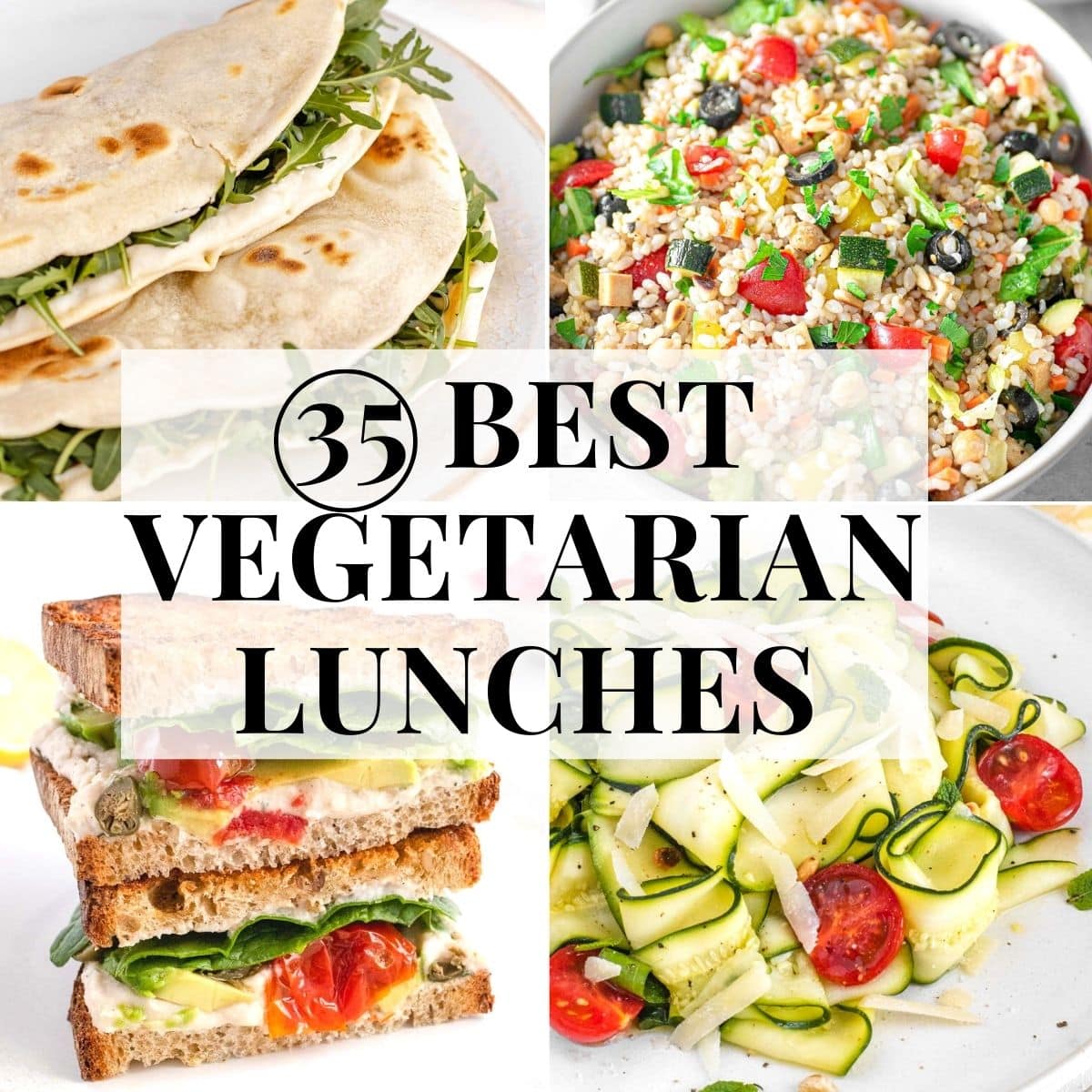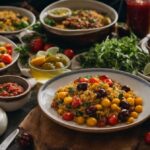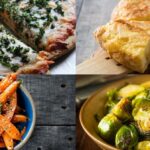Embark on a culinary journey with 30 delectable vegetarian recipes, perfectly tailored for any occasion. From quick weeknight dinners to impressive holiday feasts, this collection offers a vibrant array of flavors and textures, showcasing the incredible versatility of plant-based cuisine. Imagine vibrant colors bursting from plates, aromas filling your kitchen, and the satisfying crunch of perfectly roasted vegetables. This isn’t just a cookbook; it’s a passport to a world of delicious possibilities, where every meal is a celebration.
Discover ingenious ingredient swaps to cater to various dietary needs and preferences, effortlessly adapting recipes to suit your taste. Learn to master step-by-step instructions for diverse dishes, each accompanied by stunning photography that will inspire your own culinary creations. Explore detailed nutritional information, expert tips for enhancing presentation, and efficient meal planning strategies to minimize food waste and maximize flavor combinations. Prepare to be amazed by the ease and elegance of vegetarian cooking.
Recipe Categorization by Occasion
This collection of 30 vegetarian recipes is thoughtfully organized to cater to a wide range of occasions, from simple weeknight dinners to elaborate holiday feasts. The recipes are designed to be both delicious and accessible, utilizing readily available ingredients and straightforward techniques. This categorization allows for easy navigation and selection based on your specific needs and the context of your meal.
Recipe Categorization Table
This table provides a concise overview of ten recipes, categorized by occasion, highlighting their main ingredients and a brief description. The recipes are designed to showcase the diversity and adaptability of vegetarian cuisine.
| Occasion | Recipe Name | Main Ingredients | Description |
|---|---|---|---|
| Weeknight Dinner | One-Pan Roasted Vegetables with Chickpeas | Broccoli, bell peppers, chickpeas, red onion, olive oil, herbs | A simple, healthy, and flavorful meal ready in under 30 minutes. |
| Weeknight Dinner | Lentil Soup | Red lentils, carrots, celery, onion, vegetable broth, spices | Hearty and comforting, perfect for a chilly evening. |
| Holiday Feast | Butternut Squash Risotto | Butternut squash, Arborio rice, vegetable broth, Parmesan cheese (optional), sage | Creamy and decadent, a show-stopping dish for any holiday gathering. |
| Holiday Feast | Mushroom Wellington | Mushrooms, puff pastry, lentils, herbs, vegetable broth | A vegetarian twist on a classic, impressive and flavorful. |
| Brunch | Spinach and Feta Quiche | Spinach, feta cheese, eggs, pastry crust, milk | A classic brunch dish, easily adaptable to different preferences. |
| Brunch | Sweet Potato Hash with Fried Eggs (vegetarian option with tofu scramble) | Sweet potatoes, onions, bell peppers, tofu (optional), eggs (optional) | A hearty and flavorful brunch option, customizable for different dietary needs. |
| Potluck | Pasta Salad with Roasted Vegetables | Pasta, roasted vegetables (zucchini, eggplant, bell peppers), pesto, mozzarella cheese (optional) | A crowd-pleasing dish, easy to transport and serve. |
| Potluck | Black Bean Salsa with Tortilla Chips | Black beans, corn, red onion, tomatoes, cilantro, lime juice | Fresh, vibrant, and perfect for sharing. |
| Quick Lunch | Avocado Toast with Everything Bagel Seasoning | Avocado, whole-wheat bread, everything bagel seasoning | Simple, quick, and satisfying. |
| Quick Lunch | Caprese Salad | Tomatoes, mozzarella, basil, balsamic glaze | A classic Italian salad, fresh and light. |
Visual Representation of Recipe Categories
Imagine a vibrant pie chart. Each slice represents a recipe category (Weeknight Dinners, Holiday Feasts, Brunches, Potlucks, Quick Lunches, etc.). The size of each slice corresponds to the number of recipes in that category. For instance, Weeknight Dinners might constitute the largest slice, reflecting the higher number of recipes designed for quick, everyday meals. Within each slice, smaller icons could represent the most popular ingredients in that category. For example, the Weeknight Dinners slice might feature icons for lentils, chickpeas, and vegetables, while the Holiday Feasts slice might highlight butternut squash, mushrooms, and puff pastry. A legend would clearly identify each category and ingredient. The overall effect would be a visually appealing and informative representation of the recipe collection’s diversity and balance. The color scheme would be warm and inviting, using earthy tones to reflect the natural ingredients featured in the recipes.
Versatility of Vegetarian Cuisine
Vegetarian cuisine is remarkably versatile. Simple ingredient swaps can easily adapt recipes for various dietary needs and preferences. For example, a recipe calling for dairy cheese can easily be adapted for vegans by substituting it with nutritional yeast or vegan cheese alternatives. Similarly, gluten-free options can be created by replacing wheat-based pasta with gluten-free alternatives like brown rice pasta or quinoa pasta. Individuals with nut allergies can easily substitute sunflower seeds or pumpkin seeds for nuts in recipes. These simple adjustments demonstrate the inclusive nature of vegetarian cooking, making it accessible and enjoyable for a wide range of individuals with different dietary restrictions.
Recipe Presentation and Photography

Visually appealing vegetarian dishes are as much about the artistry of presentation as they are about the deliciousness of the food itself. A thoughtfully plated dish can elevate a simple recipe to a culinary masterpiece, enticing the diner with its beauty before they even take a bite. This section will explore techniques for enhancing the visual appeal of vegetarian cuisine, focusing on plating, garnishes, and photography.
Plating Techniques, Garnishes, and Color Combinations
Effective plating involves more than just arranging food on a plate; it’s about creating a visually harmonious and balanced composition. Consider the shape, size, and color of each element, arranging them to create visual interest and guide the eye. Garnishes add a final touch of elegance and flavor, complementing the main dish without overpowering it. Strategic color combinations can enhance the overall aesthetic, creating a vibrant and appealing presentation.
- Example 1: Roasted Butternut Squash Risotto. A vibrant orange risotto is beautifully complemented by a sprinkle of toasted pumpkin seeds for texture and a contrasting color, and a swirl of sage-infused brown butter adds richness and visual depth. The plate itself should be a simple, neutral color to allow the risotto’s warm hues to stand out. A small sprig of fresh rosemary provides a final aromatic touch.
- Example 2: Rainbow Veggie Bowl. This dish showcases a variety of colorful vegetables, such as roasted red peppers, vibrant purple cabbage, bright yellow squash, and deep green spinach. Arranging the vegetables in a visually appealing pattern, perhaps in a spiral or concentric circles, creates visual harmony. A drizzle of tahini dressing adds a creamy texture and a light color contrast. Toasted sunflower seeds add crunch and a pop of yellow.
- Example 3: Spinach and Ricotta Stuffed Shells. The rich green of the spinach contrasts beautifully with the creamy white of the ricotta filling. Arranging the shells in a slightly overlapping pattern creates a sense of abundance. A simple garnish of fresh basil leaves adds a touch of green and freshness, while a sprinkle of grated Parmesan cheese adds a textural and visual element.
Visually Appealing Vegetarian Recipes
These recipes are designed to highlight contrasting colors and textures, creating visually stunning dishes.
- Recipe 1: Red Beet and Goat Cheese Salad with Pistachios. The deep red of the roasted beets contrasts beautifully with the creamy white of the goat cheese and the pale green of the fresh spinach. Toasted pistachios add a contrasting texture and a pop of green. A simple vinaigrette ties the flavors and colors together. Preparation: Roast beets until tender, crumble goat cheese, toss with spinach, pistachios, and vinaigrette.
- Recipe 2: Creamy Avocado and Black Bean Tacos. The vibrant green of the avocado contrasts with the dark purple-black of the black beans. A sprinkle of chopped cilantro adds a pop of fresh green, while a dollop of sour cream or Greek yogurt adds a creamy white element. The warm yellow of the corn tortillas provides a base for the vibrant ingredients. Preparation: Mash avocado, mix with black beans, cilantro, lime juice, and spices. Fill tortillas and serve with toppings.
- Recipe 3: Roasted Sweet Potato and Kale with Maple-Dijon Dressing. The deep orange of the roasted sweet potatoes contrasts beautifully with the deep green of the kale. A maple-dijon dressing adds a touch of sweetness and a glossy sheen, enhancing the visual appeal. Toasted pecans add a contrasting texture and a warm brown hue. Preparation: Roast sweet potatoes and kale until tender. Toss with maple-dijon dressing and toasted pecans.
High-Quality Food Photography of Vegetarian Dishes
High-quality food photography captures not only the visual appeal but also the essence of the dish. Lighting, composition, and styling are key elements in creating an image that conveys the taste and texture.
Lighting: Natural light is ideal, but soft, diffused light is crucial to avoid harsh shadows. Consider using a diffuser to soften the light. Backlighting can create a beautiful glow, while side lighting can highlight texture. The light should be even, highlighting the colors and details without creating harsh contrasts.
Composition: The rule of thirds is a helpful guideline for composition. Place the main subject off-center to create a more dynamic image. Consider the background, keeping it simple and uncluttered to avoid distracting from the food. A shallow depth of field can help isolate the subject and create a visually appealing blur in the background.
Styling: Consider the overall aesthetic, including props and background elements. Choose a plate and background that complements the dish’s colors and style. Garnishes can add visual interest and texture, but avoid overcrowding the plate. A few strategically placed elements can enhance the image without being distracting. Consider the texture of the food, using props to emphasize its smoothness, crispness, or other textural qualities.
Conveying Taste and Texture: The image should evoke the senses. Show the glossy sheen of a sauce, the crispness of a vegetable, or the creamy texture of a cheese. Use close-up shots to highlight details, and consider using a variety of angles to show different aspects of the dish. The vibrant colors and textures should invite the viewer to imagine the taste and feel of the food.
Recipe Scaling and Meal Planning
Mastering the art of recipe scaling and meal planning unlocks a world of culinary efficiency and minimizes food waste. By understanding how to adjust ingredient quantities and strategically plan your meals, you can transform your kitchen into a well-oiled machine, effortlessly creating delicious and satisfying vegetarian meals throughout the week. This section will provide practical guidance on scaling recipes and creating a sample weekly meal plan, demonstrating how to efficiently utilize leftover ingredients.
Recipe scaling involves adjusting the quantities of ingredients to serve a different number of people than the original recipe specifies. This is achieved by calculating the ratio between the original serving size and the desired serving size, then applying this ratio to each ingredient. Accurate scaling ensures consistent flavor and texture, preventing dishes from being overly salty, bland, or unbalanced.
Adjusting Recipe Quantities
To illustrate recipe scaling, let’s take a simple example: a lentil soup recipe that serves four. Suppose you want to increase the recipe to serve six. The ratio is 6 servings / 4 servings = 1.5. Therefore, you would multiply the quantity of each ingredient by 1.5. For instance, if the original recipe calls for 1 cup of lentils, you would now use 1.5 cups. The same principle applies to decreasing the serving size; simply divide the ingredient quantities by the appropriate ratio. Consider using a spreadsheet or calculator to streamline this process, particularly for complex recipes with many ingredients.
Weekly Vegetarian Meal Plan
This meal plan utilizes seven recipes, incorporating leftovers to minimize waste and maximize flavor. Assume each recipe initially serves four, unless otherwise specified.
Monday: Creamy Tomato Soup (serves 6) – A hearty and flavorful soup, perfect for a chilly evening. Leftovers can be used in Tuesday’s recipe.
Tuesday: Tomato Soup & Grilled Cheese Sandwiches – Utilize leftover tomato soup as a base for dipping the sandwiches. This reduces cooking time and creates a satisfying meal.
Wednesday: Black Bean Burgers (serves 4) – These flavorful burgers can be served on buns with your favorite toppings. Any leftover patties can be used in Thursday’s recipe.
Thursday: Black Bean Burger Quesadillas – A quick and easy meal utilizing leftover black bean burgers. Simply warm the patties and add them to tortillas with cheese and other desired fillings.
Friday: Spinach and Ricotta Stuffed Shells (serves 4) – A comforting and satisfying pasta dish. Leftover filling can be used in Saturday’s recipe.
Saturday: Spinach and Ricotta Stuffed Crepes – Use the leftover filling from Friday’s stuffed shells to create delicious and elegant crepes. This saves time and reduces food waste.
Sunday: Vegetable Paella (serves 6) – A vibrant and flavorful rice dish, perfect for a relaxed Sunday meal. Leftovers can be enjoyed for lunch throughout the week.
Shopping List
Creating a comprehensive shopping list based on the meal plan is crucial for efficient grocery shopping and minimizing food waste. This list would include ingredients for all seven recipes, considering the scaling adjustments and the use of leftovers. The list would be organized by grocery category (produce, grains, dairy, etc.) for ease of shopping. For example, the list would include specific quantities of lentils, tomatoes, black beans, spinach, ricotta cheese, rice, various vegetables, and spices, adjusted according to the serving sizes.
Utilizing Leftover Ingredients
Strategic use of leftovers is key to reducing food waste and enhancing culinary creativity. The meal plan above exemplifies this. The leftover tomato soup from Monday is repurposed as a dipping sauce on Tuesday. Similarly, leftover black bean burgers become the star of Thursday’s quesadillas. The filling from Friday’s stuffed shells finds new life in Saturday’s crepes. This approach not only reduces waste but also allows for exploring creative flavor combinations and saving time in the kitchen. For instance, leftover roasted vegetables can be added to omelets, frittatas, or salads, adding depth of flavor and texture.
With this comprehensive guide to 30 vegetarian recipes, you’ll not only expand your culinary repertoire but also discover a newfound appreciation for the boundless creativity and deliciousness of plant-based cooking. From simple weeknight meals to elaborate holiday spreads, you’ll find inspiration and practical guidance to create memorable meals for every occasion. The journey of flavor awaits – let your culinary imagination soar!
Questions Often Asked
Can I substitute ingredients in these recipes?
Absolutely! The guide provides detailed information on ingredient substitutions, considering taste, texture, and nutritional value to help you adapt recipes to your preferences and dietary needs.
Are these recipes suitable for beginners?
Yes! The recipes are designed with clear, step-by-step instructions, making them accessible to cooks of all skill levels. Many recipes focus on simple techniques and readily available ingredients.
How do I store leftovers?
Proper storage instructions are provided with each recipe, ensuring your delicious creations stay fresh and flavorful. Generally, leftovers should be stored in airtight containers in the refrigerator.
Where can I find high-quality vegetarian ingredients?
Farmers’ markets, specialty grocery stores, and online retailers are excellent sources for fresh, high-quality vegetarian ingredients. Look for locally sourced produce whenever possible.
How long do these recipes take to prepare?
Preparation and cooking times vary depending on the recipe, ranging from quick weeknight meals to more elaborate dishes. Each recipe clearly states the estimated preparation and cooking time.


